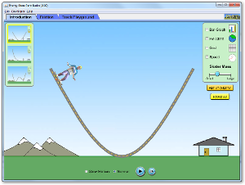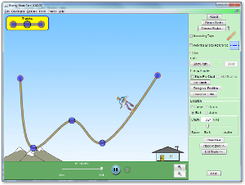4.3 - Gravitational Potential and Kinetic Energy
Objectives:
- To know the equations for Gravitational Potential and Kinetic Energy and be able to use them in a variety of different situations.
Gravitation Potential Energy (\(GPE\) or \(PE\) or \(U_{g}\)) is the stored energy due to an object's height from the ground. It is the work done in lifting the object or the work done in dropping it. Either way, the equation is straightforward from \(work = force \times distance\). The height is the vertical height.
\[GPE = U_{g}=mg\Delta h\]
Of course, the above equation assumes that the Earth's gravitational field strength is a constant. This is true on a small scale, which is usually what we consider. However, if we moved to a planetary scale, \(g\) is no longer a constant and somewhat dependent on distance. We must start to be careful with signs as well. Strictly speaking, the \(GPE\) at infinity is zero, so if the object loses \(GPE\) as it falls, the value of \(GPE\) is negative. This seems confusing at first. On a local scale, we are really dealing with a DIFFERENCE of \(GPE\) due to a DIFFERENCE in height, so the sign really does not matter. On a planetary scale it can be important.
\[g=\frac{GM}{r^2}\]
Assuming that the height = radius, which is the case if we are some distance away:
\[mgh=\frac{GMmr}{r^2}\]
\[GPE = -\frac{GMm}{r}\]
The energy associated with a moving object is called the Kinetic Energy \(KE\) or \(K\) and is equal to the work done to stop it. Remember that the work is a measure of the effort required to do a task. The derivation comes from kinematics and Newton's Second Law.
\[KE=K=\frac{1}{2}mv^2\]
\[GPE = U_{g}=mg\Delta h\]
Of course, the above equation assumes that the Earth's gravitational field strength is a constant. This is true on a small scale, which is usually what we consider. However, if we moved to a planetary scale, \(g\) is no longer a constant and somewhat dependent on distance. We must start to be careful with signs as well. Strictly speaking, the \(GPE\) at infinity is zero, so if the object loses \(GPE\) as it falls, the value of \(GPE\) is negative. This seems confusing at first. On a local scale, we are really dealing with a DIFFERENCE of \(GPE\) due to a DIFFERENCE in height, so the sign really does not matter. On a planetary scale it can be important.
\[g=\frac{GM}{r^2}\]
Assuming that the height = radius, which is the case if we are some distance away:
\[mgh=\frac{GMmr}{r^2}\]
\[GPE = -\frac{GMm}{r}\]
The energy associated with a moving object is called the Kinetic Energy \(KE\) or \(K\) and is equal to the work done to stop it. Remember that the work is a measure of the effort required to do a task. The derivation comes from kinematics and Newton's Second Law.
\[KE=K=\frac{1}{2}mv^2\]

